Prediction Model of the Sound Speed of Seafloor Sediments on the Continental Shelf of the East China Sea Based on Empirical Equations
Abstract
:1. Introduction
2. Study Area and Methodology
2.1. Location of Study Area
2.2. Data Source
2.3. Methods
3. Result
3.1. Single Parameter Prediction Equations for Sediment Sound Speed
3.2. Dual Parameter Prediction Equations for Sediment Sound Speed
4. Discussion
4.1. Sensitivity of Physical Parameters to Sediment Sound Speed
4.2. Comparison between Different Prediction Equations
5. Conclusions
- Establishment of Single and Dual Parameter Prediction Equations: Through regression analysis, single parameter and dual parameter prediction equations for sediment sound speed in the East China Sea shelf area have been established. Judging from the coefficient of determination (R2) of the single equations, sediment sound speed is strongly correlated with water content, density, void ratio, mean grain size and median grain size with the R2 greater than 0.80. The dual parameter prediction equations all have R2 values greater than 0.85, which is higher than the R2 values of the single parameter prediction equations. This indicates that the dual parameter prediction equations have a better performance for the sediment sound speed prediction. The prediction equations established in this study serve as a valuable supplement to the acoustic property prediction equations for coastal seafloor sediments.
- Order of Sensitivity of Physical-Mechanical Parameters to Sound Speed: In terms of sensitivity to sediment sound speed, the sensitivity of physical parameters ranks from the highest to the lowest as follows: void ratio, density, compressibility coefficient, median grain size and mean grain size. This is helpful for the selection of sediment physical parameters when establishing the sound velocity prediction equation for seafloor sediments.
- Comparative Analysis of Prediction Equations: The comparison of the prediction results of sediment sound speed among different prediction equations indicates that there may be significant differences between different prediction equations. The maximum difference of the single parameter prediction equations based on porosity is 120 m/s. For the dual parameter prediction equations based on density and porosity, it reaches 173.67 m/s. These differences remind us that it is necessary to select appropriate prediction equations which are suitable to the study sea area when using prediction equations for sound velocity prediction.
Author Contributions
Funding
Institutional Review Board Statement
Informed Consent Statement
Data Availability Statement
Acknowledgments
Conflicts of Interest
References
- Beebe, J.; McDaniel, S.; Rubano, L. Shallow-water transmission loss prediction using the Biot sediment model. J. Acoust. Soc. Am. 1982, 71, 1417–1426. [Google Scholar] [CrossRef]
- Collins, M.D. A higher-order parabolic equation for wave propagation in an ocean overlying an elastic bottom. J. Acoust. Soc. Am. 1989, 86, 1459–1464. [Google Scholar] [CrossRef]
- Chen, S.; Wu, L.; Zhang, R.; Li, Z.; James, F.L.; Timothy, F.D.; Arthur, E.N. Internal wave characteristics in the South China Sea and the associated fluctuations in the acoustic field. Prog. Nat. Sci. 2004, 14, 1163–1170. [Google Scholar]
- Kim, D.C.; Kim, G.Y.; Yi, H.I.; Seo, Y.K.; Lee, G.S.; Jung, J.H.; Kim, J.C. Geoacoustic provinces of the South Sea shelf off Korea. Quat. Int. 2012, 263, 139–147. [Google Scholar] [CrossRef]
- Schock, S.G. Remote estimates of physical and acoustic sediment properties in the South China Sea using chirp sonar data and the Biot model. IEEE J. Ocean. Eng. 2004, 29, 1218–1230. [Google Scholar] [CrossRef]
- Yang, K.; Lei, B.; Ma, Y. Subcritical scattering field and signal-to-reverberation ratio from buried objects. Tech. Acoust. 2007, 26, 1081–1088. [Google Scholar]
- Hodges, R.P. Underwater Acoustics: Analysis, Design and Performance of Sonar; John Wiley & Sons: Hoboken, NJ, USA, 2011. [Google Scholar]
- Zhang, S. Geoacoustics: An important subject in the study of the seabed. Physics 1997, 26, 280–285. [Google Scholar]
- Panda, S.; LeBlanc, L.R.; Schock, S.G. Sediment classification based on impedance and attenuation estimation. J. Acoust. Soc. Am. 1994, 96, 3022–3035. [Google Scholar] [CrossRef]
- Kim, G.Y.; Richardson, M.D.; Bibee, D.L.; Kim, D.C.; Wilkens, R.H.; Shin, S.R.; Song, S.T. Sediment types determination using acoustic techniques in the Northeastern Gulf of Mexico. Geosci. J. 2004, 8, 95–103. [Google Scholar] [CrossRef]
- Pszonka, J.; Schulz, B. SEM Automated Mineralogy applied for the quantification of mineral and textural sorting in submarine sediment gravity flows. Gospod. Surowcami Miner.-Miner. Resour. Manag. 2022, 38, 105–131. [Google Scholar]
- Stoll, R.D. Acoustic waves in ocean sediments. Geophysics 1977, 42, 715–725. [Google Scholar] [CrossRef]
- Buckingham, M.J. Compressional and shear wave properties of marine sediments: Comparisons between theory and data. J. Acoust. Soc. Am. 2005, 117, 137–152. [Google Scholar] [CrossRef] [PubMed]
- Hamilton, E.L.; Bachman, R.T. Sound velocity and related properties of marine sediments. J. Acoust. Soc. Am. 1982, 72, 1891–1904. [Google Scholar] [CrossRef]
- Meng, X.; Liu, B.; Kan, G.; Li, G. An experimental study on acoustic properties and their influencing factors of marine sediment in the southern Huanghai Sea. Acta Oceanol. Sin. 2012, 34, 74–83. [Google Scholar]
- Kan, G.; Liu, B.; Han, G.; Li, G.; Zhao, Y. Application of in-situ measurement technology to the survey of seafloor sediment acoustic properties in the Huanghai Sea. Acta Oceanol. Sin. 2010, 32, 88–94. [Google Scholar]
- Wang, J.; Li, G.; Liu, B.; Kan, G.; Sun, Z.; Meng, X.; Hua, Q. Experimental study of the ballast in situ sediment acoustic measurement system in South China Sea. Mar. Georesources Geotechnol. 2018, 36, 515–521. [Google Scholar] [CrossRef]
- Lu, B.; Ganxian, L.; Shaojian, H. Correlation between sound speed and physical parameters of shallow sediments in Nansha sea area. In Proceedings on Sound and Light Fields in Nansha Sea Area; China Ocean Press: Beijing, China, 1996; pp. 9–22. [Google Scholar]
- Anderson, R.S. Statistical correlation of physical properties and sound velocity in sediments. In Physics of Sound in Marine Sediments; Springer: Berlin/Heidelberg, Germany, 1974; pp. 481–518. [Google Scholar]
- Orsi, T.H.; Dunn, D.A. Sound velocity and related physical properties of fine-grained abyssal sediments from the Brazil Basin (South Atlantic Ocean). J. Acoust. Soc. Am. 1990, 88, 1536–1542. [Google Scholar] [CrossRef]
- Hou, Z. The Correlation of Seafloor Sediment Acoustic Properties and Physical Parameters in the Southern South China Sea; Insitute of Oceannology, Chinese Academy of Sciences: Qingdao, China, 2016. [Google Scholar]
- Hamilton, E.L. Sound velocity as a function of depth in marine sediments. J. Acoust. Soc. Am. 1985, 78, 1348–1355. [Google Scholar] [CrossRef]
- Hamilton, E.L. Geoacoustic modeling of the sea floor. J. Acoust. Soc. Am. 1980, 68, 1313–1340. [Google Scholar] [CrossRef]
- Hamilton, E.L. Elastic properties of marine sediments. J. Geophys. Res. 1971, 76, 579–604. [Google Scholar] [CrossRef]
- Hamilton, E.L. Low sound velocities in high-porosity sediments. J. Acoust. Soc. Am. 1956, 28, 16–19. [Google Scholar] [CrossRef]
- Bachman, R.T. Acoustic and physical property relationships in marine sediment. J. Acoust. Soc. Am. 1985, 78, 616–621. [Google Scholar] [CrossRef]
- Lu, B.; Li, G.; Liu, Q.; Huang, S.; Zhang, F. Sea floor sediment and its acouso-physical properties in the southeast open sea area of Hainan Island in China. Mar. Georesources Geotechnol. 2008, 26, 129–144. [Google Scholar] [CrossRef]
- Tang, Y. The Relationship between porosity of sea bed sediment and sound velocity. Acta Oceanol. Sin. 1998, 20, 39–43. [Google Scholar]
- Zou, D.; Wu, B.; Lu, B. Analysis and study on the sound velocity empirical equations of seafloor sediments. Acta Oceanol. Sin. 2007, 29, 43–50. [Google Scholar]
- Wang, J.; Kan, G.; Li, G.; Meng, X.; Zhang, L.; Chen, M.; Liu, C.; Liu, B. Physical properties and in situ geoacoustic properties of seafloor surface sediments in the East China Sea. Front. Mar. Sci. 2023, 10, 1195651. [Google Scholar] [CrossRef]
- Bachman, R.T. Estimating velocity ratio in marine sediment. J. Acoust. Soc. Am. 1989, 86, 2029–2032. [Google Scholar] [CrossRef]
- Hamilton, E.L. Prediction of in-situ acoustic and elastic properties of marine sediments. Geophysics 1971, 36, 266–284. [Google Scholar] [CrossRef]
- Lu, B.; Liang, Y. Statistical correlation between physical parameters of marine sediments and sound velocity in the southeast coast of China. Sci. Sin. 1994, 24, 556–560. [Google Scholar]
- Pan, G.; Ye, Y.; Lai, X.; Chen, X.; Lü, X. Shear wave velocity of seabed sediment from laboratory measurements and its relationship with physical properties of sediment. Acta Oceanol. Sin. 2006, 28, 64–68. [Google Scholar]
- Liu, S.; Shi, X.; Fang, X.; Dou, Y.; Liu, Y.; Wang, X. Spatial and temporal distributions of clay minerals in mud deposits on the inner shelf of the East China Sea: Implications for paleoenvironmental changes in the Holocene. Quat. Int. 2014, 349, 270–279. [Google Scholar] [CrossRef]
- Zhang, K.; Li, A.; Huang, P.; Lu, J.; Liu, X.; Zhang, J. Sedimentary responses to the cross-shelf transport of terrigenous material on the East China Sea continental shelf. Sediment. Geol. 2019, 384, 50–59. [Google Scholar] [CrossRef]
- Saltelli, A.; Andres, T.; Homma, T. Sensitivity analysis of model output: An investigation of new techniques. Comput. Stat. Data Anal. 1993, 15, 211–238. [Google Scholar] [CrossRef]
- Saltelli, A. Making best use of model evaluations to compute sensitivity indices. Comput. Phys. Commun. 2002, 145, 280–297. [Google Scholar] [CrossRef]
- Jackson, D.; Richardson, M. High-Frequency Seafloor Acoustics; Springer Science & Business Media: Berlin/Heidelberg, Germany, 2007. [Google Scholar]
- Williams, K.L.; Jackson, D.R.; Thorsos, E.I.; Tang, D.; Schock, S.G. Comparison of sound speed and attenuation measured in a sandy sediment to predictions based on the Biot theory of porous media. IEEE J. Ocean. Eng. 2002, 27, 413–428. [Google Scholar] [CrossRef]
- Pszonka, J.; Schulz, B.; Sala, D. Application of mineral liberation analysis (MLA) for investigations of grain size distribution in submarine density flow deposits. Mar. Pet. Geol. 2021, 129, 105109. [Google Scholar] [CrossRef]
- Sun, Z.; Sun, L.; Li, G.; Kan, G.; Guo, C.; Wang, J.; Meng, X. The relationship between the acoustic characteristics and physical properties of deep-sea sediments in the Philippine Sea. Mar. Sci. 2018, 5, 12–22. [Google Scholar]
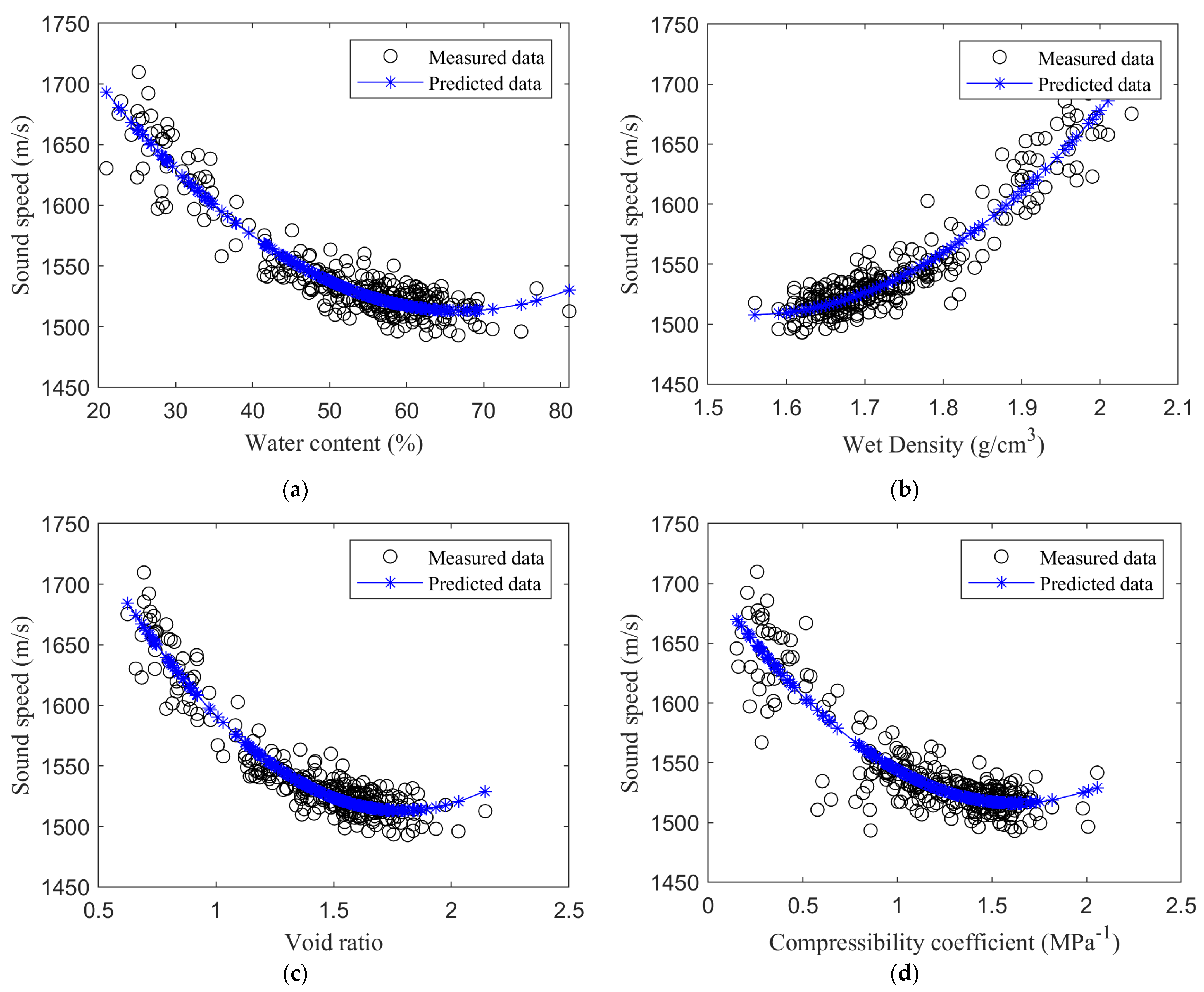

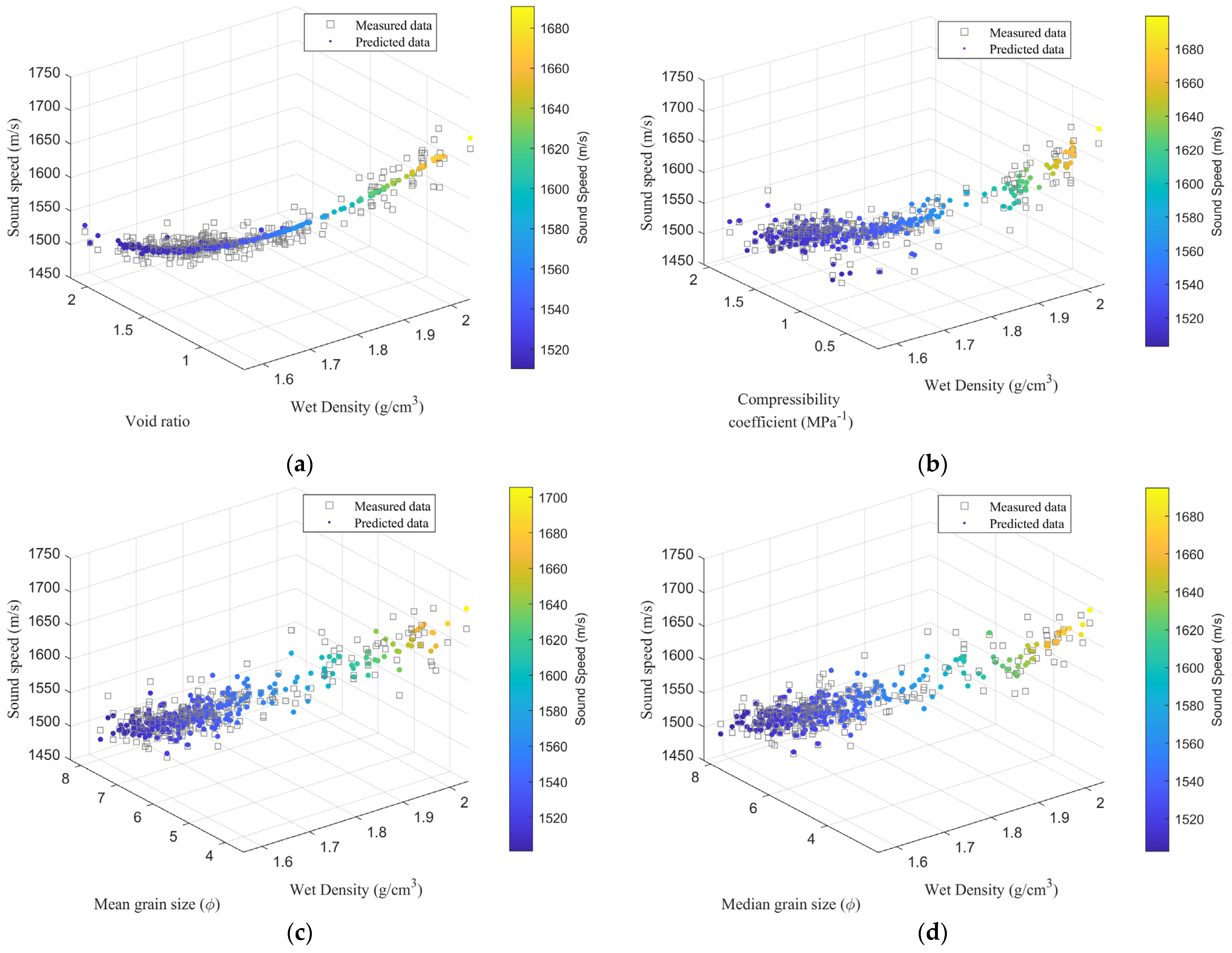
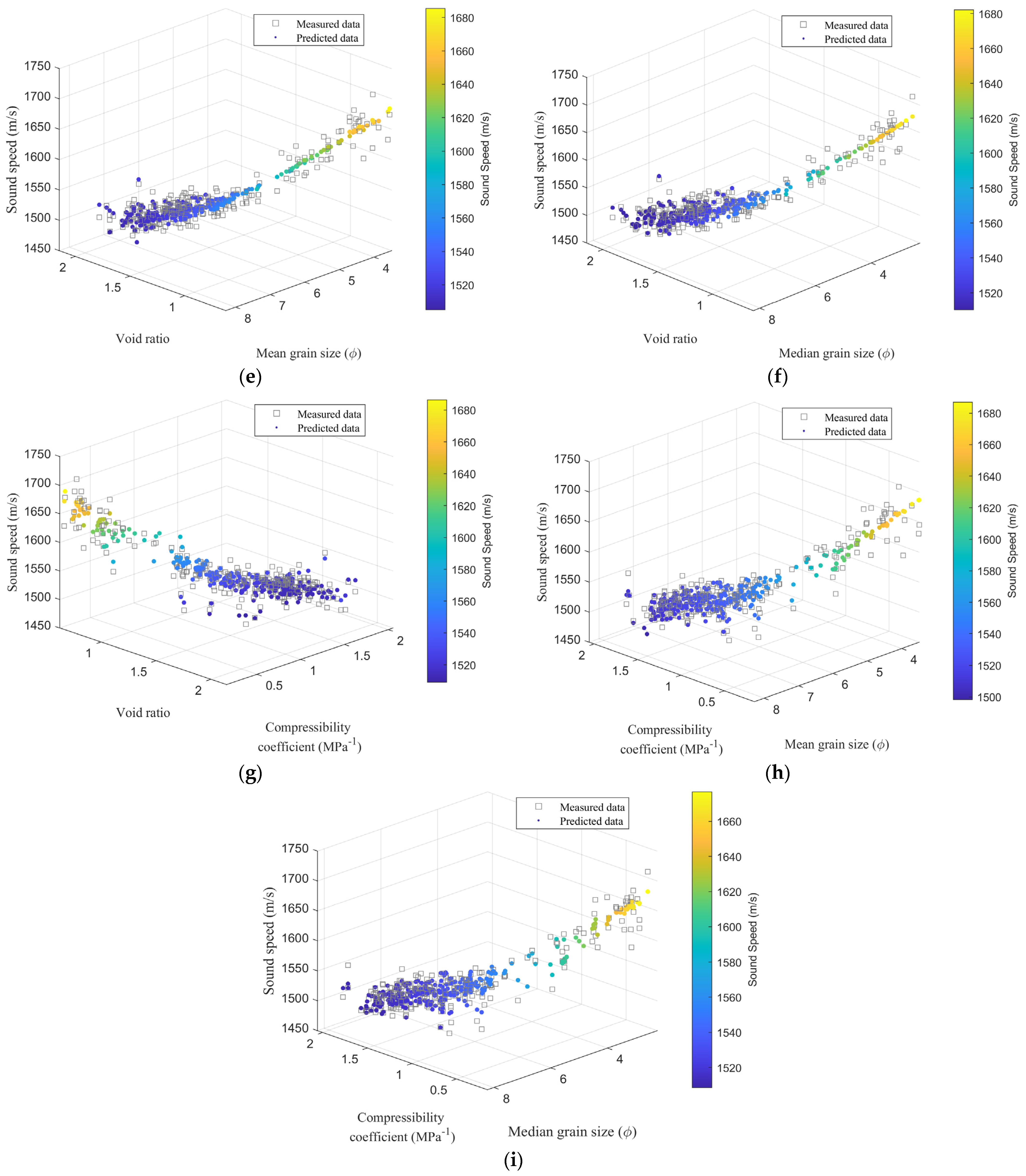
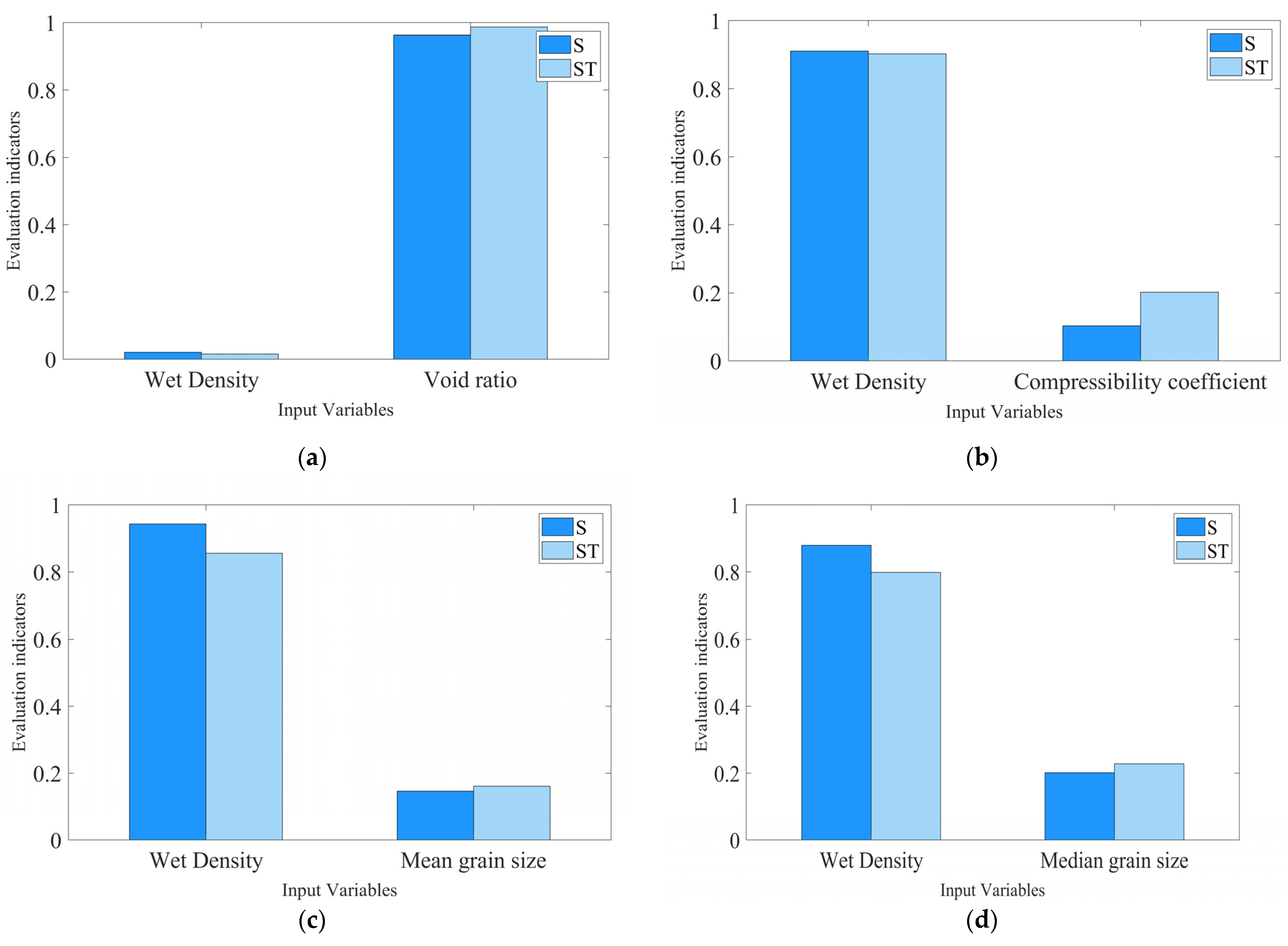
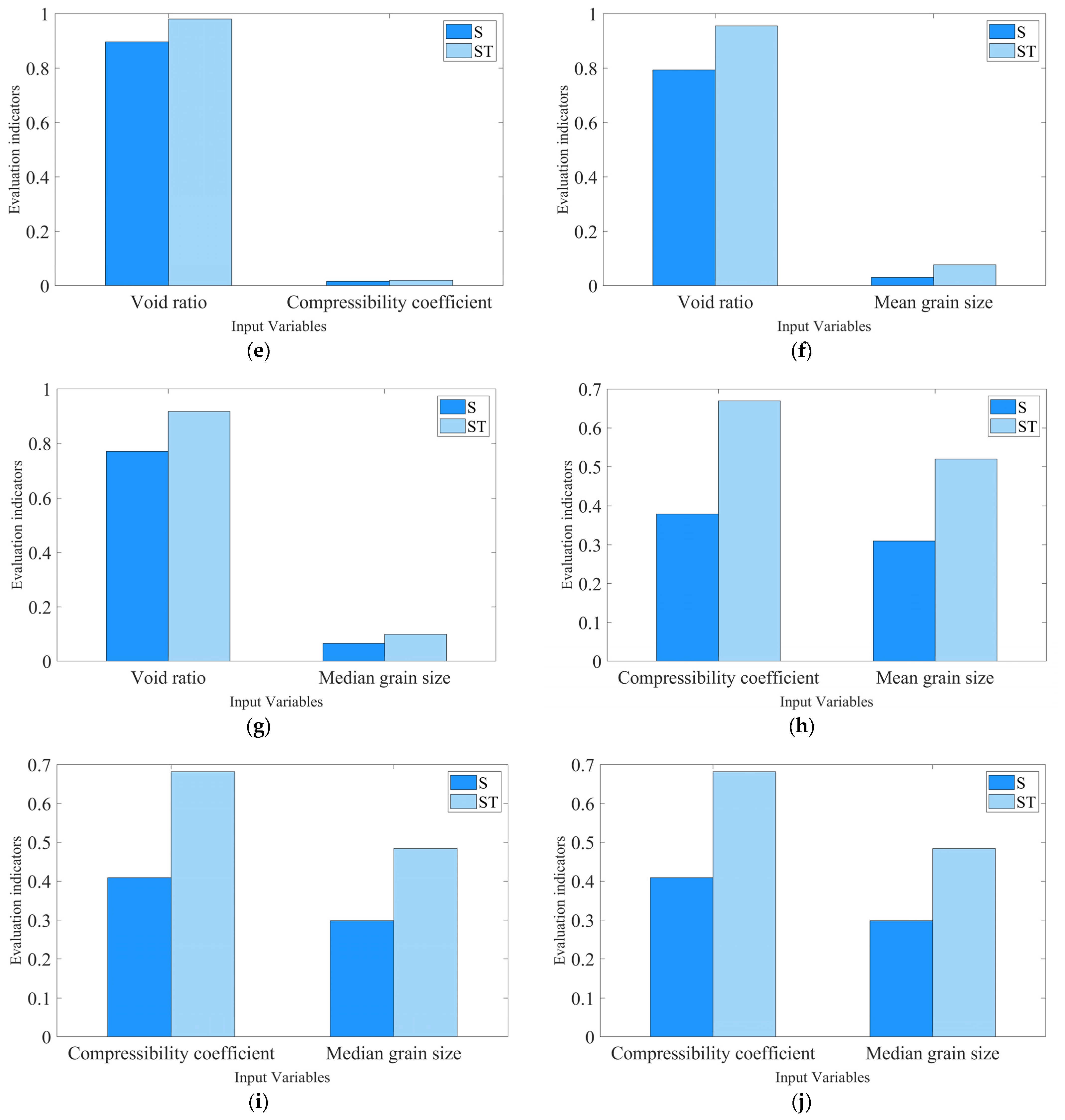
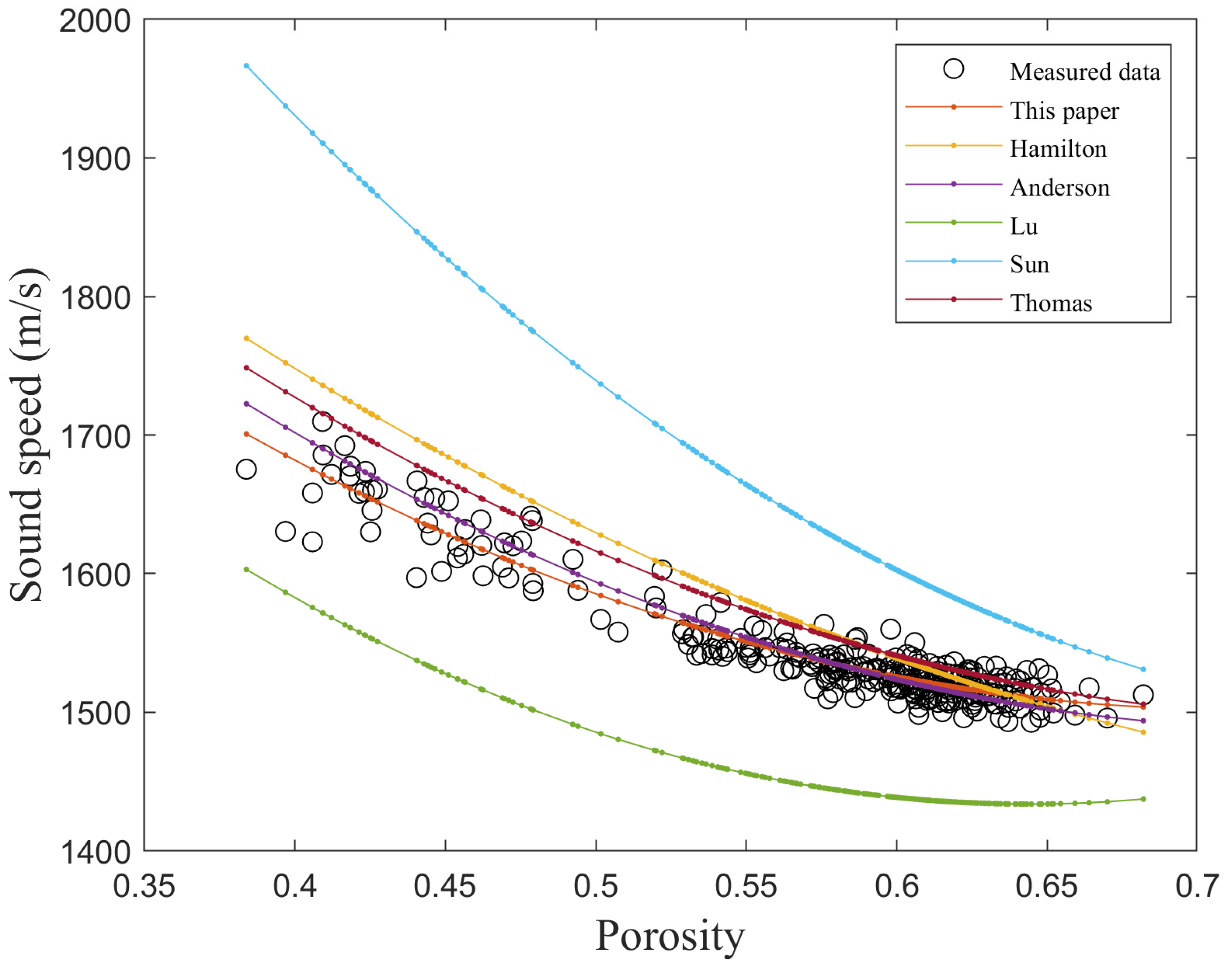
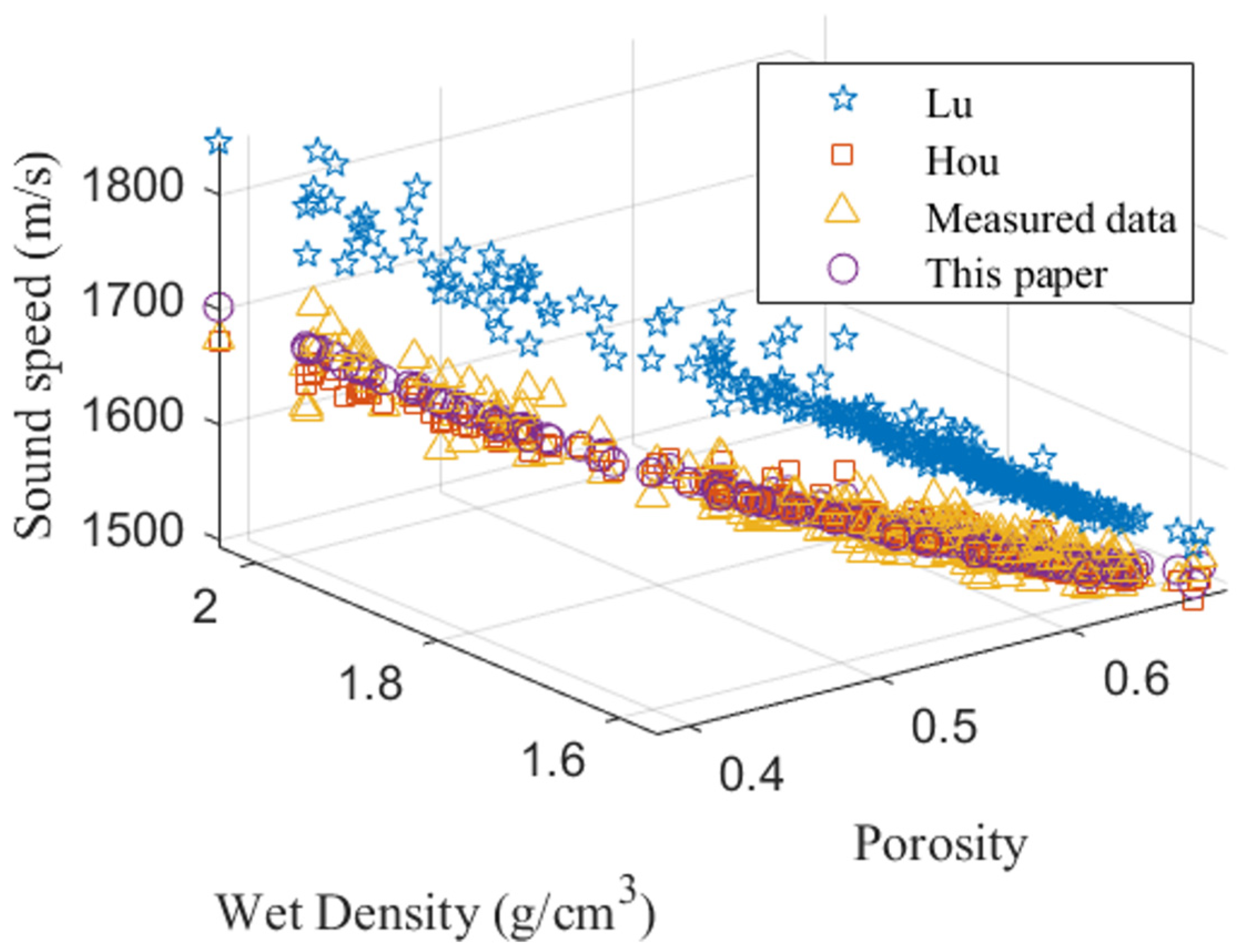
| Sediment Type | c (m/s) | w (%) | ρ (g/cm3) | e | a (MPa−1) | E (MPa) | Mz (ϕ) | Md (ϕ) | |
|---|---|---|---|---|---|---|---|---|---|
| Fine Sand | Maximum | 1692.31 | 27.65 | 1.99 | 0.79 | 0.22 | 9.88 | 3.78 | 2.91 |
| Minimum | 1597.16 | 26.45 | 1.92 | 0.71 | 0.18 | 8.28 | 4.29 | 3.00 | |
| Average | 1649.53 | 26.98 | 1.96 | 0.74 | 0.20 | 8.86 | 3.98 | 2.95 | |
| Silty Sand | Maximum | 1636.47 | 39.50 | 1.92 | 1.08 | 0.86 | 5.46 | 4.77 | 4.12 |
| Minimum | 1583.60 | 28.30 | 1.81 | 0.80 | 0.34 | 2.45 | 5.41 | 4.99 | |
| Average | 1610.51 | 32.11 | 1.89 | 0.89 | 0.49 | 4.36 | 5.14 | 4.59 | |
| Clayey Sand | Maximum | 1673.75 | 32.40 | 2.00 | 0.89 | 0.61 | 6.40 | 4.17 | 2.73 |
| Minimum | 1596.91 | 25.70 | 1.90 | 0.70 | 0.27 | 3.19 | 4.80 | 2.98 | |
| Average | 1650.60 | 28.48 | 1.97 | 0.77 | 0.36 | 5.42 | 4.34 | 2.86 | |
| Coarse Silt | Maximum | 1598.47 | 81.10 | 1.88 | 2.14 | 1.62 | 6.53 | 5.21 | 4.88 |
| Minimum | 1509.69 | 28.75 | 1.59 | 0.86 | 0.28 | 1.58 | 7.53 | 7.53 | |
| Average | 1537.90 | 53.23 | 1.73 | 1.42 | 1.16 | 2.28 | 6.32 | 6.08 | |
| Sand Clay | Maximum | 1533.33 | 65.60 | 1.73 | 1.86 | 1.69 | 1.89 | 7.03 | 7.09 |
| Minimum | 1503.61 | 54.80 | 1.61 | 1.44 | 1.39 | 1.69 | 8.29 | 8.23 | |
| Average | 1513.73 | 60.97 | 1.65 | 1.67 | 1.54 | 1.77 | 7.67 | 7.74 | |
| Sandy Silt | Maximum | 1709.78 | 37.90 | 2.04 | 1.09 | 0.86 | 11.37 | 3.49 | 2.24 |
| Minimum | 1587.96 | 21.00 | 1.78 | 0.62 | 0.15 | 2.51 | 5.60 | 5.01 | |
| Average | 1642.96 | 29.35 | 1.93 | 0.82 | 0.40 | 5.40 | 4.49 | 3.36 | |
| Clayey Silt | Maximum | 1638.27 | 76.85 | 1.90 | 2.03 | 2.06 | 4.56 | 5.70 | 5.06 |
| Minimum | 1492.86 | 32.05 | 1.56 | 0.90 | 0.42 | 1.25 | 7.74 | 7.97 | |
| Average | 1524.68 | 56.29 | 1.69 | 1.53 | 1.31 | 2.02 | 6.94 | 6.89 | |
| Parameters | Equations | R2 |
|---|---|---|
| Water content (w) | 0.886 | |
| Density (ρ) | 0.868 | |
| Void ratio (e) | 0.894 | |
| Compressibility coefficient (a) | 0.792 | |
| Compressibility modulus (E) | 0.730 | |
| Mean grain size (Mz) | 0.808 | |
| Median grain size (Md) | 0.827 |
| Parameters | Equations | R2 |
|---|---|---|
| Density-void ratio (ρ, e) | 0.895 | |
| Density-compressibility coefficient (ρ, a) | 0.873 | |
| Density-mean grain size (ρ, Mz) | 0.885 | |
| Density-median grain size (ρ, Md) | 0.891 | |
| Void ratio-compressibility coefficient (e, a) | 0.896 | |
| Void ratio-mean grain size (e, Mz) | 0.900 | |
| Void ratio-median grain size (e, Md) | 0.904 | |
| Compressibility coefficient-mean grain size (a, Mz) | 0.855 | |
| Compressibility coefficient-median grain size (a, Md) | 0.869 |
| Parameters | Equations | R2 |
|---|---|---|
| Density-void ratio (ρ, e) | 0.895 | |
| Density—compressibility coefficient (ρ, a) | 0.873 | |
| Density—mean grain size (ρ, Mz) | 0.885 | |
| Density—median grain size (ρ, Md) | 0.891 | |
| Void ratio-compressibility coefficient (e, a) | 0.896 | |
| Void ratio—mean grain size (e, Mz) | 0.900 | |
| Void ratio—median grain size (e, Md) | 0.904 | |
| Compressibility coefficient—mean grain size (a, Mz) | 0.855 | |
| Compressibility coefficient—median grain size (a, Md) | 0.869 | |
| Mean grain size—median grain size (Mz, Md) | 0.829 |
| Author | Single Parameter Prediction Equation | Background of Equation Establishment |
|---|---|---|
| Hamilton [14] | Based on data collected in continental shelf | |
| Anderson [19] | Based on data of sediments from the less than 1500 m deep seafloor | |
| Thomas [20] | Based on sediment core samples collected from the offshore margin of the Brazilian continental shelf to the Pernambuco deep-sea plain, with an average water depth of 5047 m. | |
| Bo Lu [27] | Based on the data collected in the northern continental shelf of South China Sea | |
| Sun [42] | Based on sediment core Samples collected from the seabed at depths ranging from 3164 to 5592 m in the Philippine deep sea | |
| This study | Based on the data collected in the shelf of East China Sea |
| Author | Single Parameter Prediction Equation | Background of Equation Establishment |
|---|---|---|
| Lu [18] | Based on the data collected in continental shelf of South China Sea | |
| Hou [21] | Based on the data of data in the southern South China Sea | |
| This study | Based on the data collected in the shelf of the East China Sea |
Disclaimer/Publisher’s Note: The statements, opinions and data contained in all publications are solely those of the individual author(s) and contributor(s) and not of MDPI and/or the editor(s). MDPI and/or the editor(s) disclaim responsibility for any injury to people or property resulting from any ideas, methods, instructions or products referred to in the content. |
© 2023 by the authors. Licensee MDPI, Basel, Switzerland. This article is an open access article distributed under the terms and conditions of the Creative Commons Attribution (CC BY) license (https://creativecommons.org/licenses/by/4.0/).
Share and Cite
Kan, G.; Lu, J.; Meng, X.; Wang, J.; Zhang, L.; Li, G.; Liu, B.; Hua, Q.; Chen, M. Prediction Model of the Sound Speed of Seafloor Sediments on the Continental Shelf of the East China Sea Based on Empirical Equations. J. Mar. Sci. Eng. 2024, 12, 27. https://doi.org/10.3390/jmse12010027
Kan G, Lu J, Meng X, Wang J, Zhang L, Li G, Liu B, Hua Q, Chen M. Prediction Model of the Sound Speed of Seafloor Sediments on the Continental Shelf of the East China Sea Based on Empirical Equations. Journal of Marine Science and Engineering. 2024; 12(1):27. https://doi.org/10.3390/jmse12010027
Chicago/Turabian StyleKan, Guangming, Junjie Lu, Xiangmei Meng, Jingqiang Wang, Linqing Zhang, Guanbao Li, Baohua Liu, Qingfeng Hua, and Mujun Chen. 2024. "Prediction Model of the Sound Speed of Seafloor Sediments on the Continental Shelf of the East China Sea Based on Empirical Equations" Journal of Marine Science and Engineering 12, no. 1: 27. https://doi.org/10.3390/jmse12010027
APA StyleKan, G., Lu, J., Meng, X., Wang, J., Zhang, L., Li, G., Liu, B., Hua, Q., & Chen, M. (2024). Prediction Model of the Sound Speed of Seafloor Sediments on the Continental Shelf of the East China Sea Based on Empirical Equations. Journal of Marine Science and Engineering, 12(1), 27. https://doi.org/10.3390/jmse12010027







